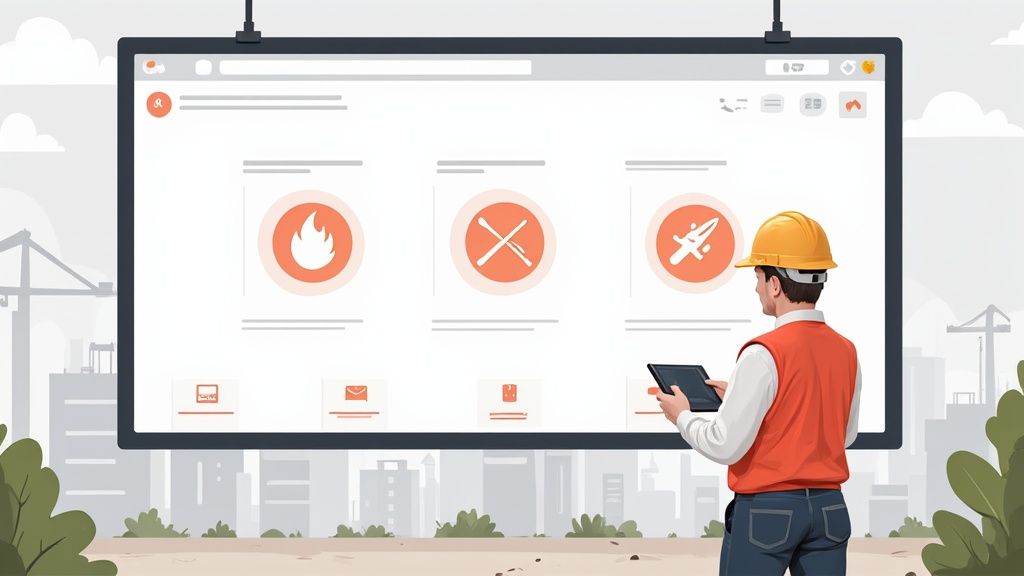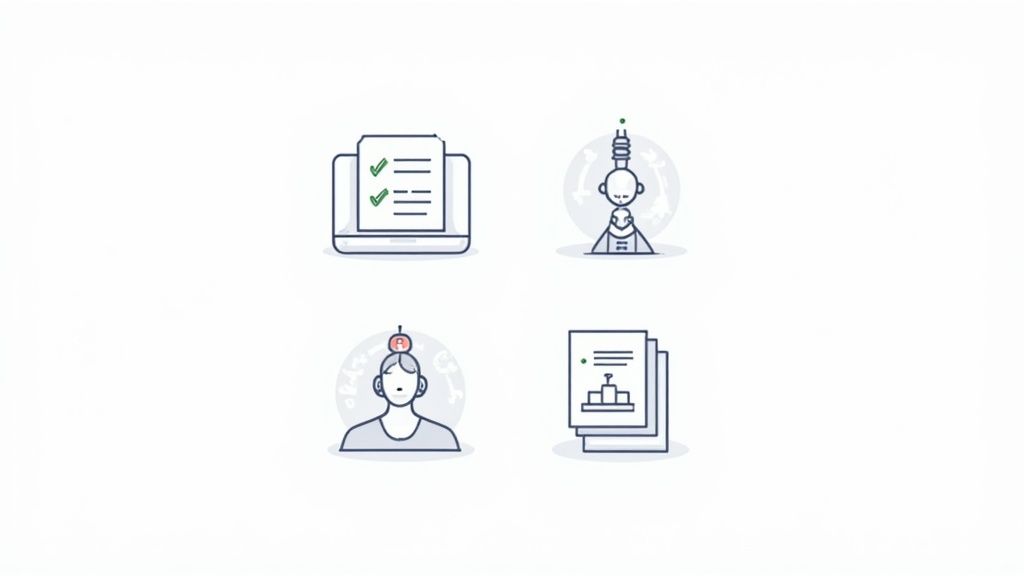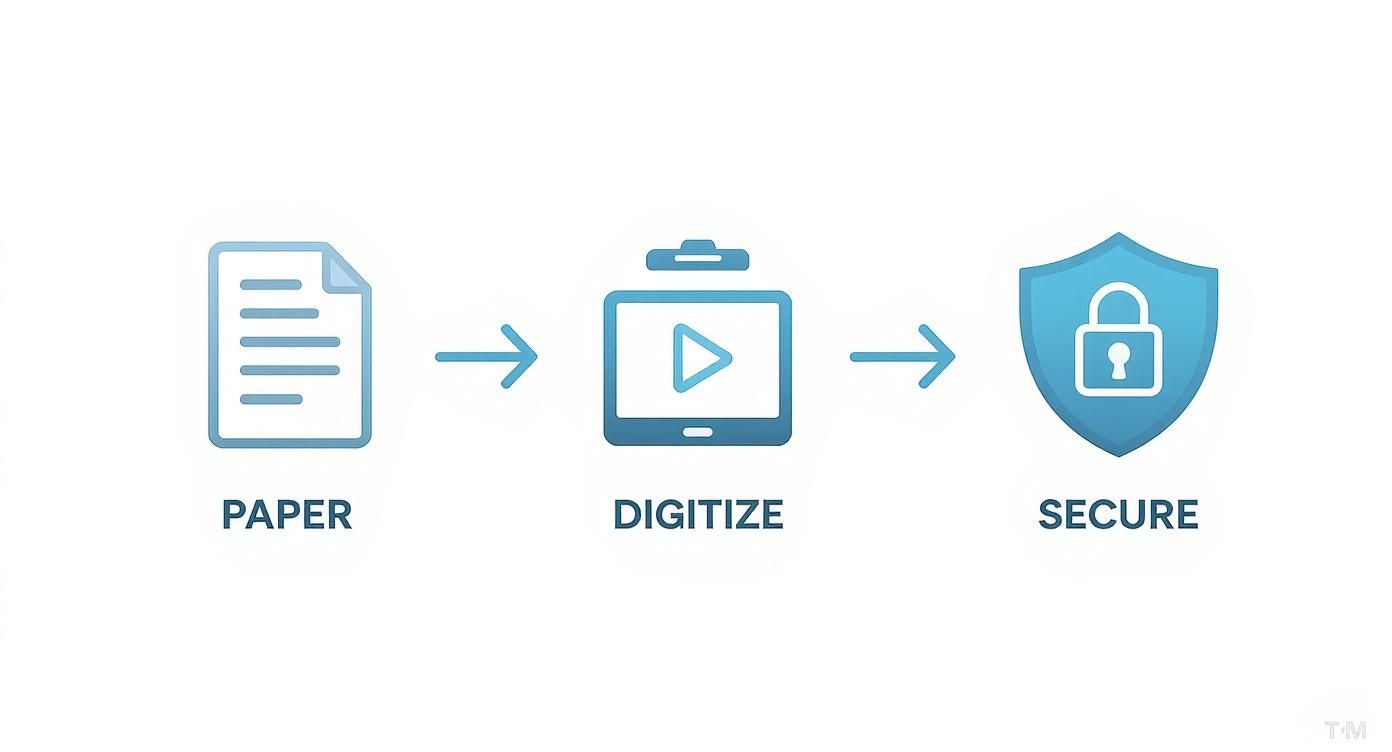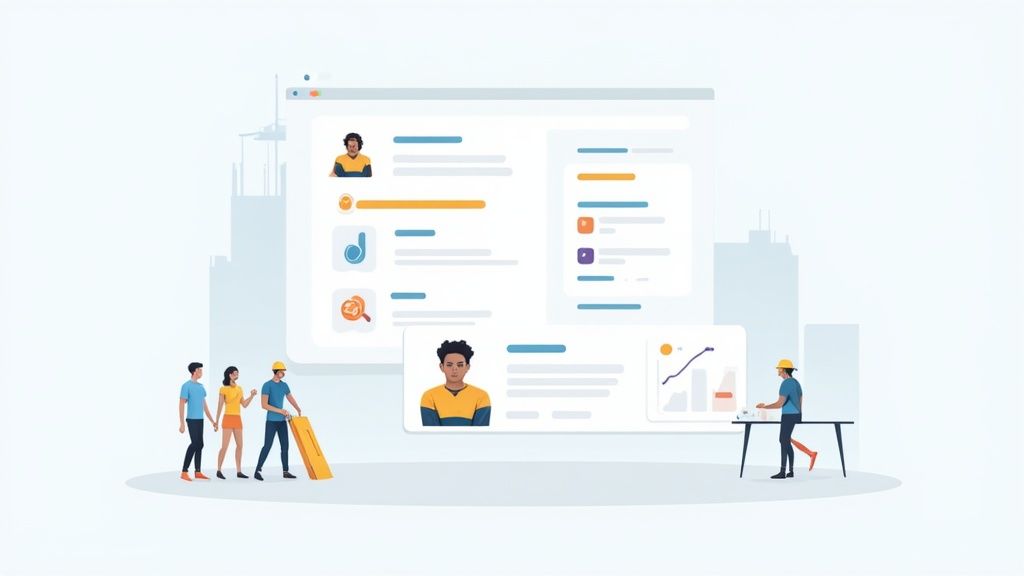A risk management system is a structured, practical tool that helps you find, assess, and control potential problems in your workplace. It’s designed to turn the often messy job of managing risks into a clear, repeatable process for your operational teams.
What Exactly Are Risk Management Systems?
Let's cut through the jargon. Think of a risk management system as the digital dashboard for your entire operation. It gives you the critical information you need to make smart decisions before small issues spiral into costly problems.
It’s just like the dashboard in a modern truck that warns you about engine temperature or low tyre pressure before you break down. A good system gives you real-time warnings about potential trouble on a job site or factory floor.

This kind of immediate feedback is what turns a system from a simple record keeper into an active operational tool. It stops being about paperwork and becomes a practical way to spot hazards, organize a response, and track everything until it’s sorted.
Moving Beyond Spreadsheets
So many businesses start out tracking risks in spreadsheets or paper logbooks. While that’s better than nothing, this approach gets clumsy and inefficient fast, especially as your operations grow. Trying to find a specific incident report from six months ago can turn into a massive headache.
A dedicated system brings all this information into one central place. Instead of digging through folders, you have a single source of truth that’s easy for everyone who needs it to access. This structure is a core part of building a strong https://safetyspace.co/health-and-safety-management-system and makes the entire process more organized and less reliant on manual data entry.
A proper system creates an organized, auditable trail of all risk management activities. This isn't just for compliance; it gives you a clear picture of what's happening across your sites, helping you spot trends and prevent recurring issues.
The Practical Function in a Workplace
So, what does this look like day-to-day in industries like construction and manufacturing? Instead of being a compliance headache, it becomes a genuine operational advantage. For example, a system can:
- Flag High-Priority Issues: Automatically notify a supervisor when a critical hazard is identified, making sure it gets immediate attention.
- Assign Corrective Actions: When a problem is logged, the system can assign a task to a specific person with a deadline, creating clear accountability.
- Track Progress: Managers can see at a glance which risks have been dealt with and which are still outstanding, without having to chase people for updates.
This proactive approach helps keep projects on schedule and workers safe. If you're looking to explore the broader landscape of available options, you can find some great insights in articles discussing innovative risk management solutions for businesses. By turning data into direct actions, these systems make your operations far more predictable and reliable.
The Core Components of an Effective System
To really get your head around how a risk management system works, it helps to break it down into its essential parts. A good system isn't just one piece of software; it's a collection of practical, connected tools. Each bit tackles a specific step in the risk management process, from spotting a problem in the first place to making sure it’s properly fixed.
The whole point is to ditch disorganized paper trails and clunky spreadsheets. What you get instead is a clear, structured way to handle hazards so that nothing gets missed and everyone knows exactly what they’re responsible for.
Digital Risk Identification
Everything starts with identifying risks. Modern risk management systems swap out paper checklists and scribbled notes for simple digital forms. This one change has a massive impact on both efficiency and accuracy.
Armed with a tablet or phone, a worker on a construction site can log a potential hazard the second they see it, complete with photos and notes. There’s no chance of a form getting lost, rained on, or ending up unreadable. The information is captured in a standard format and zips straight into a central system for the right people to see.
This is what it looks like in practice, a worker using a tablet on-site to fill out a digital risk assessment, capturing data right at the source.

This immediate, on-the-spot data entry cuts out delays and dramatically improves the quality of the information you’re working with.
Assessment and Prioritization
Once a risk is on the radar, the next job is to figure out how serious it is. This is where built-in assessment tools come into play. They often use a simple matrix that calculates a risk score based on two key factors.
- Likelihood: How likely is it that this hazard will actually cause an incident?
- Consequence: If something does happen, how bad would the outcome be?
By assigning a score, the system automatically flags the most dangerous issues. A situation with a high likelihood and severe consequences, think unguarded machinery in a busy walkway, gets pushed to the top of the list for immediate action. It takes the guesswork out of the equation and helps managers focus resources where they’re needed most.
A well-organized system turns subjective opinions into objective data. It provides a consistent method for evaluating every risk, making sure that critical dangers are never overlooked because someone underestimated the potential harm. This consistency is vital for maintaining a productive workplace.
Control Measure Tracking
Spotting and assessing a risk is only half the battle. The crucial next step is actually doing something about it. This is where control measure tracking becomes essential.
When a risk needs action, the system lets a manager assign a specific task to a person or team. This task, or ‘control measure’, comes with a clear description of what needs to be done and a firm deadline.
For example, a worker flags a trip hazard from loose cables on a factory floor. The supervisor can jump into the system and assign a task to the maintenance team to secure those cables by the end of the shift. The system then tracks this task, sends out reminders, and requires the team to confirm when the job is done, often with a photo as proof. This closes the loop and creates crystal-clear accountability.
Reporting and Analytics Dashboards
Finally, any decent risk management system gives you simple, clear reporting. Dashboards offer a bird's-eye view of all risk-related activities across the entire operation. Instead of drowning in stacks of paper, a manager can see the most important information at a glance.
These dashboards can reveal important trends, like:
- The most common types of hazards being reported across different sites.
- How quickly corrective actions are being completed on average.
- Which departments or locations have the most outstanding risks.
This information is gold for making bigger, strategic decisions. If reports show a spike in manual handling injuries in one warehouse, management can dig into the root cause and bring in better equipment or training. It also makes it incredibly easy to generate compliance reports for regulators, proving that the business has a structured and active process for managing its risks.
Why Your Business Needs a Formal System
So, we've talked about what a risk management system is. Now let’s get into the why. Why should you bother setting up a formal system? It really comes down to practical, measurable results.
This isn't about creating more bureaucracy or paperwork for the sake of it. It’s about building a more stable, predictable, and financially sound operation by getting ahead of problems before they do any real damage. When you take a structured approach to risk, it has a direct impact on your bottom line by reducing costly incidents, preventing expensive project delays, and protecting your business from major disruptions.
Drive Down Costly Incidents and Delays
Every incident, whether it’s a minor equipment failure or a serious injury, has a price tag. There are the obvious direct costs like repairs and medical bills, but the indirect ones, lost productivity and project setbacks, are often where the real pain is felt.
A formal risk management system is your tool for spotting the conditions that lead to these events and fixing them before they happen.
Think about it this way: by tracking minor equipment faults in a central system, you might spot a recurring issue with a specific machine. This lets you schedule preventative maintenance long before a major breakdown occurs, saving you from days of unplanned downtime and blown deadlines. It's a simple, proactive approach that keeps your operations running smoothly.
A clean, organized work environment is one of the clearest signs of effective risk management in action.
This kind of setup doesn't happen by chance. It’s the direct result of a system that consistently identifies and controls hazards, from trip risks to poorly stored materials.
Simplify and Prove Regulatory Compliance
Meeting your regulatory obligations can feel like a massive headache, especially if you're in a high-risk industry like construction or manufacturing. A formal system takes a lot of that pain away by creating a clear, auditable trail of all your risk management activities.
When an inspector turns up and asks how you’re managing a specific hazard, you’re not left scrambling through filing cabinets.
Instead, you can instantly pull up digital records that show:
- When a risk was first identified.
- How it was properly assessed.
- What control measures were put in place to manage it.
- Who was responsible for the action and when it was completed.
This digital paper trail is your proof of due diligence. It shows regulators you have a robust, active process for managing risks, which can be the key to avoiding hefty fines and keeping your operational licenses. It turns compliance from a stressful, reactive chore into a manageable, ongoing process.
Get a Handle on People-Related Risks
Risks aren't just about physical hazards anymore. Today, businesses face huge "people risks", everything from skills shortages and high staff turnover to poor subcontractor performance. These challenges can derail a project just as easily as faulty equipment.
A good risk management system helps you see these critical business threats coming and plan for them. For instance, if you identify a shortage of certified welders as a major risk to an upcoming project, the system lets you formally track it and assign clear actions. That might mean kicking off a recruitment drive early or investing in upskilling your current team to fill the gap.
This has become a major worry for Australian businesses. Recent research shows that over a quarter of C-suite executives now name talent and people as a top-three risk, a huge jump from just 12% the previous year. In sectors like real estate and construction, 39% of leaders flagged people risk as a top concern, a clear sign of just how hard it is to find and keep skilled workers. You can explore more about these findings and how industries are adapting to the global risk landscape.
By formally tackling these human-factor risks, you build a much more resilient operation. You’re not just hoping you have the right people on hand; you’re actively managing the risk of not having them. In a tight labor market, that kind of forward-thinking gives you a massive competitive advantage.
Integrating Digital Tools into Your Workflow
Making the jump from paper checklists and spreadsheets to a digital system can feel like a massive step, but it’s where modern risk management really comes alive. It's not about chasing the latest tech fad. It's about making your entire workflow practical, fast, and completely transparent.
The whole point is to get that critical information out of dusty filing cabinets and into the hands of the people who can actually do something about it.
This shift fundamentally changes how information moves through your business. A site manager with a tablet can log a new hazard, and it can pop up on an executive's dashboard in the main office almost instantly. That kind of real-time visibility means problems get sorted out faster, and everyone has a much clearer picture of what’s really happening on the ground. It completely replaces slow, clunky paper trails with a direct line of communication.
Going digital isn't just about speed, though. It also standardizes how you collect information. Every risk report follows the same format, which means your data is clean, consistent, and dead easy to analyze. This structure is the bedrock for anyone looking to implement effective health and safety management software, as it creates a reliable foundation for all your safety processes.
Making Information Accessible and Actionable
One of the biggest wins from using digital risk management systems is accessibility. Vital information is no longer locked away on a single computer or buried in a stack of folders. With a cloud-based system like Safety Space, your team can get the information they need from anywhere, whether they're on-site, in the workshop, or in a client meeting.
This immediate access makes your people more effective. Think about it: a supervisor can pull up the risk assessment for a specific job right on their phone, just before their crew starts work. This guarantees they have the most up-to-date information, rather than relying on a printed copy that might be weeks out of date.
The core idea is to close the gap between spotting a risk and controlling it. Digital tools make this connection immediate, creating a clear and accountable process where actions are assigned, tracked, and verified, all in one place.
The Critical Role of Cybersecurity
Of course, moving your operational data online introduces a new kind of risk: cyber risk. While digital tools bring enormous benefits, they have to be secure. Protecting your sensitive information, from project details to employee records, is just as important as managing physical hazards on a job site.
This has become a huge concern for Australian businesses. A recent paper from the Actuaries Institute highlights that for many companies, especially small and medium enterprises (SMEs), the gap between their actual cyber risk and what insurance covers is getting wider. As cyber threats get more sophisticated, insurers are struggling to keep up, which means businesses need rock-solid internal security. You can read the full research about emerging business risks on actuaries.asn.au.
Choosing a secure platform is non-negotiable. A good system must have robust security features baked in to protect your data from anyone who shouldn't see it. This includes things like:
- Secure Logins: Multi-factor authentication to make sure only the right people can access the system.
- Data Encryption: Protecting your information both when it's stored and when it's being sent.
- Regular Updates: The software provider should be constantly updating the system to shield it from new threats.
By picking a tool built with security in mind from day one, you can confidently get all the benefits of digital efficiency without exposing your business to unnecessary cyber threats. It ensures your risk management efforts are protected from start to finish.
Implementing Your Risk Management System
Putting a new risk management system in place doesn’t have to be some monumental, complicated project. In fact, the most successful rollouts I’ve seen always start small. They focus on solving one or two specific problems really well, and then build on that success.
The goal isn't to launch a perfect, all-encompassing system on day one. It’s about making a tangible improvement, fast. This approach minimizes disruption and, more importantly, shows your team the value of the new tool right from the get-go.
Define Your Starting Point
Before you even glance at software options, you need to be crystal clear on what you’re trying to fix. Are you constantly chasing down lost incident reports? Do you struggle to see if corrective actions are actually being completed on time? Pick one or two of your biggest headaches.
A great way to do this is to get your supervisors and team leaders in a room and ask a simple question: "What's the most frustrating or time-consuming part of our current risk process?" Their answers will give you a no-nonsense, practical place to start.
It's all about shifting from messy, outdated paper methods to a secure, digital process.

This simple shift transforms a chaotic paper trail into an organized and protected workflow, making crucial information both easy to find and secure.
Choose the Right Tools for the Job
Once you’ve identified your initial focus, you can start looking at tools. If your main issue is tracking hazards across a huge construction site, you'll want a system with a solid mobile app that works offline. If your biggest headache is organizing compliance paperwork, then features like digital forms and automated reporting should be at the top of your list.
Don't get sidetracked by a long list of shiny features you'll never use. Stay focused on how a system solves the specific problems you identified in step one. For some real-world perspective on this, especially in high-risk environments, there are great resources out there on mastering risk management in construction projects.
Get Your Team Onboard
Let’s be honest: just sending out an email with a login link and hoping for the best is a recipe for disaster. Any new system needs clear communication and hands-on training. Plan a short, practical session with the core team who will be using it first.
Focus the training on the "what's in it for me" factor. Show them how the new system will make their jobs easier, not just add another task to their day.
For example: "This app means you can report a hazard in 30 seconds with a photo, right then and there, instead of spending 15 minutes filling out a paper form back in the office." This kind of practical benefit is a key part of any good occupational health and safety management plan template.
Establish Clear Oversight and Review
A system is only as good as the process wrapped around it. You need to build in accountability from the start.
You can apply this principle quite simply:
- Assign Ownership: Make it clear who is responsible for reviewing new risks and assigning actions. No ambiguity.
- Set a Review Cadence: Schedule a brief weekly or fortnightly meeting to go over outstanding risks and check progress. Keep it short and to the point.
- Measure Success: After a month, circle back to your initial goal. Did you reduce the time it takes to close out corrective actions? Use that data to prove the system’s value and start planning your next move.
All the theory in the world doesn’t make a worksite safer. Best practices are great, but they only count when you have a practical way to put them into action. This is where a dedicated tool is no longer a nice-to-have; it's essential for turning good intentions into consistent, on-the-ground results.
Safety Space was built to be that straightforward, effective tool for busy construction and manufacturing businesses. It cuts through the complexity and directly tackles the real-world challenges of managing risk. We're talking about replacing messy paper forms and confusing spreadsheets with a clear, digital process that connects everyone, from the crew on the floor to the managers back in the office.

This simple connection makes the whole process faster, easier, and far more reliable. It makes sure critical safety information gets to the right people without falling through the cracks.
From Identification to Resolution in One System
The entire risk management lifecycle lives inside Safety Space. That means you have a single source of truth for your safety operations, instead of bits of information getting lost in emails, notebooks, or forgotten spreadsheets.
Having everything flow through one organized system solves some of the biggest headaches in safety management:
- Instant Hazard Reporting: A worker spots a hazard and can log it with photos, right there on their phone. That report is immediately visible in the system, killing the delays that come with paper reports making their way back to the office.
- Clear Accountability: When a control measure is needed, you can assign it as a task to a specific person with a deadline. The system tracks that task from open to closed, so nothing gets forgotten.
- Visible Oversight: Managers get a real-time view of all risk activities on a central dashboard. They can instantly see what’s been reported, what’s being fixed, and what’s overdue, all without having to chase people for updates.
This integrated workflow means risks get dealt with, plain and simple. It provides the structure needed to make sure every single issue is managed from start to finish.
Safety Space transforms risk management from a reactive, paper-shuffling exercise into a proactive part of your daily operations. It gives you the visibility to get ahead of problems before they cause costly disruptions or injuries.
Making Compliance Simple and Auditable
Proving your compliance to regulators can feel like a full-time job, especially when you're digging through filing cabinets or scattered digital folders to find what you need.
Safety Space builds your audit trail for you, automatically, as your team goes about their work.
Every action, from the initial risk assessment to the final sign-off on a fix, is time-stamped and logged. When you need to demonstrate due diligence, you can generate a detailed report in minutes, not days. This is what effective risk management systems should do: turn compliance into a straightforward, low-stress part of how you operate.
By pulling all the principles we've discussed into one practical platform, Safety Space makes organized, proactive risk management an achievable reality for any business.
Got Questions? We've Got Answers
Even with the best plan in the world, rolling out a new risk management system is bound to bring up a few questions. We get it. Here are some straight answers to the most common queries we hear from managers and business owners in the manufacturing and construction sectors.
How Much Does a System Like This Cost?
The investment really depends on the size of your operation and the specific features you need. Most modern systems, like Safety Space, run on a monthly subscription based on how many people will be using it.
This approach is often far more cost-effective than a massive upfront capital expense. It means updates, security, and support are all bundled in, so you don't need a dedicated IT team just to keep things running. Think of it as just another essential tool in your business's toolkit.
How Long Does It Take to Get Started?
Honestly, you can get up and running faster than you might think. A focused implementation can have your team using the core features within a few weeks, not months.
The secret is to start small. Pick one specific problem, like digitizing your incident reports, instead of trying to launch every single feature at once. This gets you a quick win and builds real momentum for a wider rollout down the track.
The most effective rollouts focus on solving one major pain point first. Once your team sees how the new tool makes their job easier in one area, they'll be much more open to adopting it for other tasks.
How Do I Prove the ROI to Senior Management?
Proving the return on your investment comes down to tracking clear, practical metrics. You need to focus on tangible improvements that hit the bottom line.
It's not as hard as it sounds. You can measure things like:
- A reduction in the average time it takes to close out corrective actions.
- A noticeable decrease in minor incidents or equipment downtime.
- The raw amount of admin time saved by ditching the old paperwork.
When you can walk into a meeting and show a 20% faster turnaround on fixing hazards or that you've cut down paperwork by several hours a week, you've built a rock-solid business case.
What Happens If My Team Won't Use It?
Adoption is all about showing value. If your team sees the system as just more admin work piled on top of their day, they’ll naturally resist. You have to frame it around how it helps them.
For example, show your crew how reporting a hazard on their phone is quicker than hunting down a form, and how it guarantees a manager sees their concern immediately. Make it a tool that solves their problems, not just another box to tick for management.
Ready to see how a practical, straightforward system can change how you work? Safety Space was designed for businesses just like yours. Book a free demo today and find out how you can simplify compliance and make your operations safer and more efficient.
Ready to Transform Your Safety Management?
Discover how Safety Space can help you build a safer, more compliant workplace with our comprehensive safety management platform.
Book a Free DemoRelated Topics
Safety Space Features
Explore all the AI-powered features that make Safety Space the complete workplace safety solution.
Articles & Resources
Explore our complete collection of workplace safety articles, tools, and resources.
